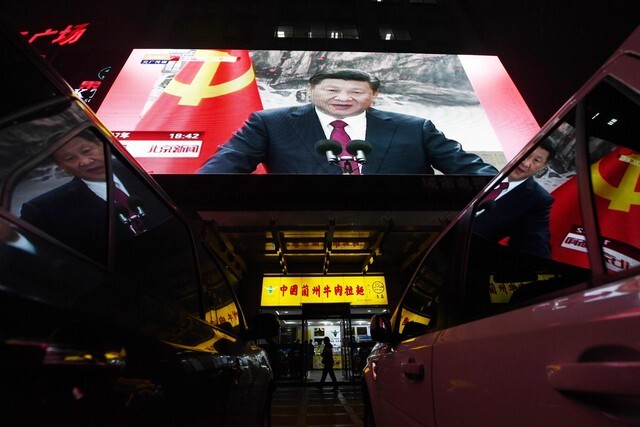hankyoreh
Links to other country sites 다른 나라 사이트 링크
South Korea to announce plans for large-scale investments in China

South Korean companies are set to announce a plan for large-scale investment in China during a bilateral summit proposed for this December by Seoul, government officials said. The South Korean government is reportedly coordinating the approval date for 1.8 trillion won (US$1.6 billion) in OLED investment in Guangzhou by LG Display.
“In addition to concerns about technology theft, we’re examining national security effects and impacts on the national economy in terms of job losses,” a senior Ministry of Trade, Industry and Energy (MOTIE) official told the Hankyoreh on Oct. 26 when asked whether the LG Display investment approval decision was connected to the plans for a South Korea-China summit.
“[South Korean] Ambassador [to China] Noh Young-min also appears to have a South Korea-China summit in mind. My understanding is that the Blue House is also taking that into account,” the official said.
The approach from Seoul suggests it is working on a “surprise package” of large-scale China investment by South Korean companies to help bring the summit about – using it as a means of easing conflicts over the THAAD missile system deployment and fostering a climate of reconciliation between the two sides. South Korean businesses in areas such as automobiles, electric car batteries, retail, and tourism have been suffering heavily due to retaliatory measures from China over THAAD.

In July, LG Display decided to establish a joint corporation in Guangzhou to produce 8.5-generation OLEDs. The board decided to invest 1.8 trillion won out of 2.6 trillion won (US$2.3 billion) in capital, but the approval is still being coordinated by MOTIE. High-tech display components, organic light-emitting diodes (OLEDs) have received 400 billion won (US$354 million) in state R&D investment over the past 10 years, and their overseas production requires expert review and government approval due to concerns about technology theft.
MOTIE’s electronics expert committee has established a separate subcommittee of display experts to weigh the approval decision. The administration plans to finish discussions at a third subcommittee meeting around Oct. 30, with a final decision to come when Minister of Trade, Industry and Energy Baek Woon-kyu holds an industry technology protection committee meeting next month.
“To date, there have not been any cases of approval being denied in the review of overseas investment cases where concerns about technology theft have been raised,” a senior administration official said.
“Instead of making this a choice between approval or disapproval, there are also options such as attaching conditions to prevent technology theft or granting approval with an adjusted investment start date.” An announcement of investment plan to expand a Samsung Electronics memory semiconductor plant in Xi’an is also expected to coincide with the South Korea-China summit.
“Samsung Electronics is scheduled to file a notice early next year for investment to expand NAND flash facilities at its Xi’an semiconductor factory,” a senior government official explained.
“Although this is a case of reporting [rather than an issue requiring approval], it would find itself in the same position [as LG Display] in terms of not being able to invest in the expansions if the government doesn’t accept the notice,” the official said.
Some are predicting Samsung Electronics may speed up its decision on the scale of investment and move up the timeline to submit a report by December. In August, the company announced plans to invest US$7 billion (around 7.8 trillion Korean won) over three years to build a second production line at its NAND flash factory in Xi’an.
By Lee Wan and Cho Kye-wan, staff reporter
Please direct questions or comments to [english@hani.co.kr]

Editorial・opinion
![[Column] Park Geun-hye déjà vu in Yoon Suk-yeol [Column] Park Geun-hye déjà vu in Yoon Suk-yeol](https://flexible.img.hani.co.kr/flexible/normal/500/300/imgdb/original/2024/0424/651713945113788.jpg) [Column] Park Geun-hye déjà vu in Yoon Suk-yeol
[Column] Park Geun-hye déjà vu in Yoon Suk-yeol![[Editorial] New weight of N. Korea’s nuclear threats makes dialogue all the more urgent [Editorial] New weight of N. Korea’s nuclear threats makes dialogue all the more urgent](https://flexible.img.hani.co.kr/flexible/normal/500/300/imgdb/original/2024/0424/7317139454662664.jpg) [Editorial] New weight of N. Korea’s nuclear threats makes dialogue all the more urgent
[Editorial] New weight of N. Korea’s nuclear threats makes dialogue all the more urgent- [Guest essay] The real reason Korea’s new right wants to dub Rhee a founding father
- [Column] ‘Choson’: Is it time we start referring to N. Korea in its own terms?
- [Editorial] Japan’s rewriting of history with Korea has gone too far
- [Column] The president’s questionable capacity for dialogue
- [Column] Are chaebol firms just pizza pies for families to divvy up as they please?
- [Column] Has Korea, too, crossed the Rubicon on China?
- [Correspondent’s column] In Japan’s alliance with US, echoes of its past alliances with UK
- [Editorial] Does Yoon think the Korean public is wrong?
Most viewed articles
- 1‘We must say no’: Seoul defense chief on Korean, USFK involvement in hypothetical Taiwan crisis
- 2N. Korean delegation’s trip to Iran shows how Pyongyang is leveraging ties with Moscow
- 3‘Weddingflation’ breaks the bank for Korean couples-to-be
- 4[Reportage] On US campuses, student risk arrest as they call for divestment from Israel
- 5Amnesty notes ‘erosion’ of freedom of expression in Korea in annual human rights report
- 6[Column] Park Geun-hye déjà vu in Yoon Suk-yeol
- 7Korea sees more deaths than births for 52nd consecutive month in February
- 8[Editorial] New weight of N. Korea’s nuclear threats makes dialogue all the more urgent
- 9Will NewJeans end up collateral damage in internal feud at K-pop juggernaut Hybe?
- 10[Guest essay] The real reason Korea’s new right wants to dub Rhee a founding father